
The terms anno Domini (AD) and before Christ (BC) are used when designating years in the Julian and Gregorian calendars. The term anno Domini is Medieval Latin and means "in the year of the Lord" but is often presented using "our Lord" instead of "the Lord", taken from the full original phrase "anno Domini nostri Jesu Christi", which translates to "in the year of our Lord Jesus Christ". The form "BC" is specific to English, and equivalent abbreviations are used in other languages: the Latin form, rarely used in English, is Ante Christum natum (ACN) or Ante Christum (AC).
Cornish is a Southwestern Brittonic language of the Celtic language family. Along with Welsh and Breton, Cornish is descended from the Common Brittonic language spoken throughout much of Great Britain before the English language came to dominate. For centuries, until it was pushed westwards by English, it was the main language of Cornwall, maintaining close links with its sister language Breton, with which it was mutually intelligible, perhaps even as long as Cornish continued to be spoken as a vernacular. Cornish continued to function as a common community language in parts of Cornwall until the mid 18th century, and there is some evidence for traditional speakers of the language persisting into the 19th century.
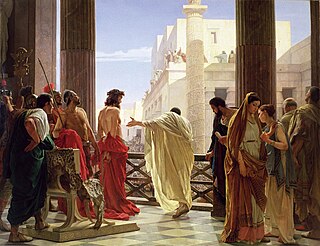
Pontius Pilate was the fifth governor of the Roman province of Judaea, serving under Emperor Tiberius from 26/27 to 36/37 AD. He is best known for being the official who presided over the trial of Jesus and ultimately ordered his crucifixion. Pilate's importance in Christianity is underscored by his prominent place in both the Apostles' and Nicene Creeds. Because the gospels portray Pilate as reluctant to execute Jesus, the Ethiopian Church believes that Pilate became a Christian and venerates him as both a martyr and a saint, a belief which is historically shared by the Coptic Church, with a feast day on 19 or 25 June, respectively.

Edward Pococke was an English Orientalist and biblical scholar.

Cornish literature refers to written works in the Cornish language. The earliest surviving texts are in verse and date from the 14th century. There are virtually none from the 18th and 19th centuries but writing in revived forms of Cornish began in the early 20th century.
Cornish bagpipes are the forms of bagpipes once common in Cornwall in the 19th century. Bagpipes and pipes are mentioned in Cornish documentary sources from c.1150 to 1830 and bagpipes are present in Cornish iconography from the 15th and 16th centuries.

The Blickling homilies are a collection of anonymous homilies from Anglo-Saxon England. They are written in Old English, and were written down at some point before the end of the tenth century, making them one of the oldest collections of sermons to survive from medieval England, the other main witness being the Vercelli Book. Their name derives from Blickling Hall in Norfolk, which once housed them; the manuscript is now at Princeton, Scheide Library, MS 71.
Cornish dance originates from Cornwall, UK. It has largely been shaped by the Cornish people and the industries they worked in. In most cases, particularly with the step dancing, the dances were still being performed across the region when they were collected.
Antoine de Longueval was a French singer and composer of the Renaissance. A contemporary of Josquin des Prez, he was singing master of the French royal chapel under King Francis I, and was important in the history of the polyphonic setting of the Passion.
Edwin Norris was a British philologist, linguist and intrepid orientalist who wrote or compiled numerous works on the languages of Asia and Africa. His best-known works are his uncompleted Assyrian Dictionary and his translation and annotation of the three plays of the Cornish Ordinalia.
William Scawen (1600–1689) was one of the pioneers in the revival of the Cornish language. He was a politician who sat in the House of Commons in 1640 and fought for the Royalist cause in the English Civil War.
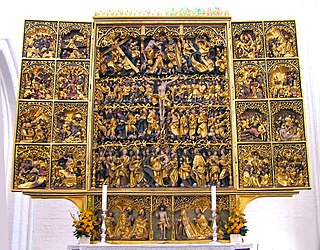
In Christian music, a Passion is a setting of the Passion of Christ. Liturgically, most Passions were intended to be performed as part of church services in the Holy Week.
Indract or Indracht was an Irish saint who, along with his companions, was venerated at Glastonbury Abbey, a monastery in the county of Somerset in south-western England. In the High Middle Ages Glastonbury tradition held that he had been an Irish pilgrim — a king's son – on his way back from Rome who was molested and killed by a local thegn after he had stopped off to visit the shrine of St Patrick. This tradition synchronised his life with that of King Ine (688–726), though historian Michael Lapidge has argued that he is most likely to represent a 9th-century abbot of Iona named Indrechtach ua Fínnachta.
William Jordan, Cornish dramatist, lived at Helston in Cornwall, and is supposed to have been the author of the Cornish language mystery or sacred drama Gwreans an Bys: the Creacon of the World. The oldest manuscript is in small folio in the Bodleian Library ; with it is a later copy; another is in the British Museum, together with a translation made by John Keigwin; and a fourth was in 1858 in the possession of John Camden Hotten; a fifth copy, perhaps the same as the fourth, was in 1890 in the possession of John Crichton-Stuart, 3rd Marquess of Bute and a sixth belonged to William Copeland Borlase.

John Keigwin (1641–1716) was a Cornish antiquary, born at Mousehole, Cornwall. He was a leading member of a group of antiquaries in west Penwith: this group also included John and Thomas Boson, William Gwavas, Thomas Tonkin, William Borlase, Oliver Pender, and James Jenkins of Alverton. His teacher was John Boson. In addition to Cornish and English, Keigwin had a command of the French, Latin, Greek and Hebrew languages.
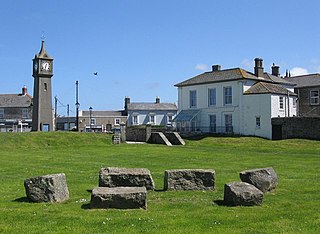
A plen-an-gwarry or plain-an-gwary, is a "playing-place" or round, a medieval amphitheatre found in Cornwall. A circular outdoor space used for plays, sports, and public events, the plen-an-gwary was a Cornish variant of a construction style found across Great Britain. Formerly common across Cornwall, only two survive nearly complete today: the Plain in St Just in Penwith and Saint Piran's Round near Perranporth.

Kresen Kernow in Redruth, United Kingdom is Cornwall's archive centre, home to the world's biggest collection of archive and library material related to Cornwall. Funded by the National Lottery Heritage Fund and Cornwall Council and opened in 2019, it brings together the collections which were previously held at Cornwall Record Office, the Cornish Studies Library and Cornwall and Scilly Historic Environment Record as well as in various outstores.
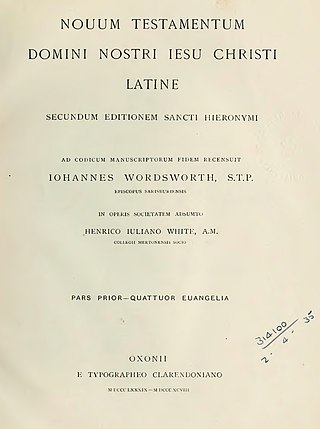
The Oxford Vulgate is a critical edition of the Vulgate version of the New Testament produced by scholars of the University of Oxford, and published progressively between 1889 and 1954 in 3 volumes.
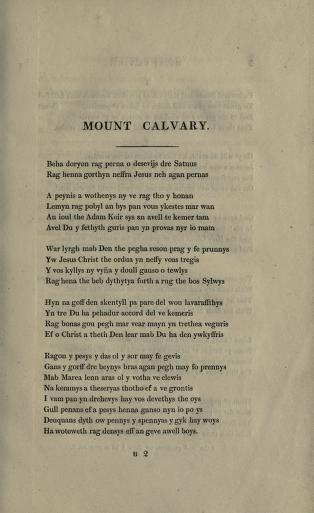
The anonymous poem Pascon agan Arluth is the oldest complete literary work in the Cornish language, dating from the 14th century. The modern title means "The Passion of Our Lord", but the poem has also been published as Mount Calvary.

The Pilate cycle is a group of various pieces of early Christian literature that purport to either be written by Pontius Pilate, or else otherwise closely describe his activities and the Passion of Jesus. Unlike the four gospels, these later writings were not canonized in the New Testament, and hence relegated to a status of apocrypha. Some writings were quite obscure, with only a few ancient textual references known today; they merely survived through happenstance, and may not have been particularly widely read by early Christians in the Roman Empire and Christians in the Middle Ages. Others were more popular. The most notable example was the Gospel of Nicodemus, which proved quite popular and influential in medieval and Renaissance Christianity.













